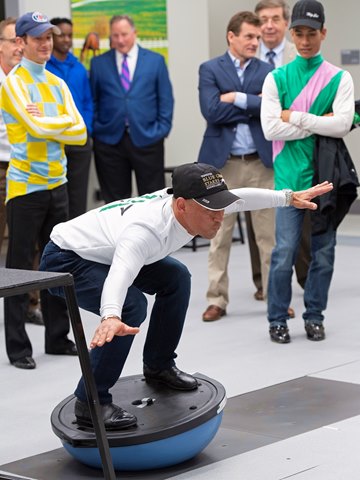Nick Heebner was amazed when world-class jockeys stepped on the Bosu ball, which he had liked a little in a balance measurement instrument. Each driver locked his sensors on the left, right, right, forward or back and used this information as a flat line on an immediately readable graphic.
The Jockeys, including the Hall of Famers Javier Castellano and John Velazquez, enjoyed a visit to the Jockey and Equestrian initiative on April 11th, part of the World Class Research Institute for Sports Medicine at the University of Kentucky. The JEI was started last autumn and aims to conduct research on jockey and riding rides, security and performance research.
Heebner, as Associate Director for Research at SMRI, had seen his mechanism-the half-hard ball looked like with a flat surface and sensors-beginners of the North American racing academy of the Bluegrass Community and Technical College Equine Program are crowded to to find or maintain the balance. But Thursday, some top drivers of Keeneland Kept the Bosu ball as high as the lower parts of its detailed Eclipse awards.
After jockey Javier Castellano demonstrated the balance on the Bosu ball, Surfer tribute tribute
“That was impressive,” said Heebner about the test, which asked the drivers to maintain their position for two minutes. It is one of the technologies that imitate real situations because the most state-of-the-art Jei tries to collect information that leads to a better understanding of driving injuries and better equipment and technology to prevent such setbacks.
Register Bloodhorse Daily
JEI director Carl Mattacola, who worked with the Jockeys' Guild and the Jockey Club, succeeded in starting the program when the Smri started the Smri under Scott Lephart. Lephart supervised a similar program at the University of Pittsburgh, which once carried out a five -year study to investigate why athletes tore their front cruciate ligaments disproportionately compared to men. This study led to programs that reduced a risk of injury and reducing injury rates in female athletes.
The JEI, one of four concentration areas within SMRI, aims to achieve similar results for jockeys and other equestrian sports. The other areas of the SMI research concentration are British athletics, military personnel and veterans in the energetic service and initiatives of the health of women. Lephart said it makes sense to include Jei in the establishment of Lexington on the British campus.
“When we came to Lexington, we wanted to bring our sports medicine capacity to this industry, the horse industry,” said Lephart. “If we can identify violation risks, reduce the risk of injury, how we diagnose, treat and rehabilitate injuries, we believe that this will have a significant impact on the industry.”
SMRI is based on the faculty – disruptive experts, medical experts as well as experts in strength and conditioning from all over the campus.
“We will, and we are on the way to becoming a worldwide leading market leader in the field of sports medical research,” said Lephart. “Especially in the event of injuries to the musculoskeletal system, when examining brain conceals – you will see demonstrations of all this time today – and study physiology and metabolism, we know that this is particularly significant for this industry, as it relates to weight management , and the factors that contribute to how these boys.
“What we want to bring into your industry is evidence and science that does not yet exist. Science and study has remained in your industry.”
Mattacola said the state -of -the -art equipment and the laboratory would support create sport -specific research that the jei of the racing industry and the public will offer.
“Jockeys and Equestrians have no access like other athletes. I said this for six years for the Jockeys' Guild – many of their children in high school and in middle school have better access to health care than our professional jockeys and serve and other equestrians it only confined research in this area.
Mattacola said research would be the emphasis with Jei.
“We need the data. We have to provide information from the riding industry to prevent injuries,” said Mattacola. “We have committed to public relations – more information about the conceals of the brain, improving the well -being and the lifelong health of the participants, but also the workforce and also helping the industry, racing and riders.”
This equipment includes an MK9 mechanical horse from England – or, as Mattacola likes to say, “imported from Great Britain to Great Britain”. The mechanical horse is surrounded by cameras that examine the balance of a driver, the pressure points and the heart rate. By collecting data on top drivers, the JEI hopes to provide fresh information.
In addition, drivers who may rehabilitate from injuries can take their progress with such devices. Castellano, Eclipse winner Jose Ortiz, and the driver Sophie Doyle, who was awarded with stakes, could see that they would get training through the mechanical horse. The Eclipse award winner Julien Leparoux tested its balance on the Bosu ball. Information that was collected from studying such top drivers will support you in his research.

Sophie Doyle on the MK9 Mechanical Horse.
Velazquez Velazquez from Jockeys' guilds could not believe what he saw in the facility.
“It is incredible. It is nice to see that something like this is dedicated to research and development and rehabilitation,” said Velazquez. “To have such a facility, we have never seen anything like that.”
While this equipment can be fun in a way, Terry Meyocks, National Manager of Jockeys Guild, said the efforts to improve the safety and health of the drivers will benefit the entire industry.
“What is significant is that this not only helps jockeys and equestrian, but also helps the racetracks, reduces liabilities, reduces the costs for guidelines on the route, the employee compensation here in Kentucky and it could be around the world. These costs helps.
“Even if we can save a life, save that a person is paralyzed, whether it is a jockey or a trainingider, it's worth it.”


